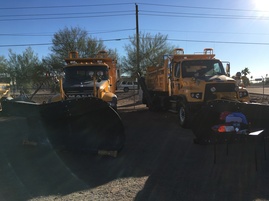 PHOENIX – One of the great things about Arizona winters is being able to savor a refreshingly mild morning in our desert communities and then play in the snow that same afternoon.
Just don’t let being able to wear shorts and flip-flops in Tucson, Bullhead City or Mesa leave you thinking that winter driving is any less challenging in Arizona’s high country than in other parts of the country. In fact, snow that makes Flagstaff, the Mogollon Rim, the White Mountains, Prescott and Mount Lemmon popular in the winter can be even more challenging because so much of it can fall in such a brief period.
“Arizona is blessed with an awesome diversity of winter weather, and we all have a chance to get out and enjoy it,” said Governor Doug Ducey. “Taking some easy steps to prepare for driving in areas with snow and ice can make the trip more enjoyable and safe for everyone.”
For starters, leave the shorts and flip-flops at home. Winter is the real deal in higher elevations, yet it’s not unheard of for motorists and passengers to be found shivering in stranded vehicles or rest areas without warm clothing, not to mention an emergency kit that includes blankets.
The average snowfall across the country is 25 inches per year. The Flagstaff area can see 90 inches or more annually, while the White Mountains region averages 30 inches per year.
Snow can fall in virtually every part of Arizona. That’s why the Arizona Department of Transportation has nearly 200 snowplows and 400 trained snowplow operators stationed all around the state to keep highways open when storms hit.
Even so, drivers should leave prepared for the possibility that snow and ice will make for a longer trip and could lead to a highway closure until snowplows can do their work. That comes down to what you take in your vehicle; how you prepare yourself, your passengers and your vehicle; and how you approach driving in potentially adverse conditions.
ADOT’s Know Snow campaign (azdot.gov/KnowSnow), which kicks off Tuesday, November 15, offers tips such as these:
-
Slow Down and Leave Extra Room: Adjust your speed to conditions. Driving slower and leaving space between your vehicle and others when snow and ice are present can improve your ability to brake and prevent skids.
-
Leave Prepared: Dress for cold weather, bring extra clothes and gloves, be sure your cellphone is charged, and pack food, water and necessary medications. Make sure your vehicle is in good working condition, starting with the battery, heater/defroster, wiper blades, wiper fluid and brakes.
-
Pack an Emergency Kit: For starters, take blankets, a flashlight, an ice scraper, a small shovel, a container of sand for traction and hazard lights or reflectors in case your vehicle becomes disabled.
-
Beware of Black Ice: Black ice tends to form at night when melting snow freezes and is especially common on bridges.
-
Stay Up to Date: Visit ADOT’s Travel Information site at az511.gov or call 511 to get the latest highway conditions, and pay attention to messages on overhead boards. ADOT’s Twitter feed (@ArizonaDOT) is an excellent source of information and answers about highway conditions.
It’s essential to know how to drive near a snowplow, starting with staying at least four vehicle lengths behind a plow and not passing until the operator pulls over. Remember: The safest place to be when snow and ice are on a highway is behind a snowplow.
For safety, be sure to exit highways completely before playing in the snow. Highway shoulders are for stranded vehicles and emergency vehicles, not for throwing snowballs. Note that a plow can throw a lot of snow and ice well off the roadway.
And travel with the knowledge that popular snow-play areas, including those along US 180 northwest of Flagstaff, can get a lot of visitors after snow falls and especially around holiday weekends. Heavy traffic can mean a slow trip back at day’s end, so be prepared to spend more time on the road than you may expect in winter weather.
“It’s thrilling to see Arizona’s high country in its winter glory,” said Governor Ducey. “We just want you to Know Snow before leaving so your trip can be safe as well as memorable.”
|


